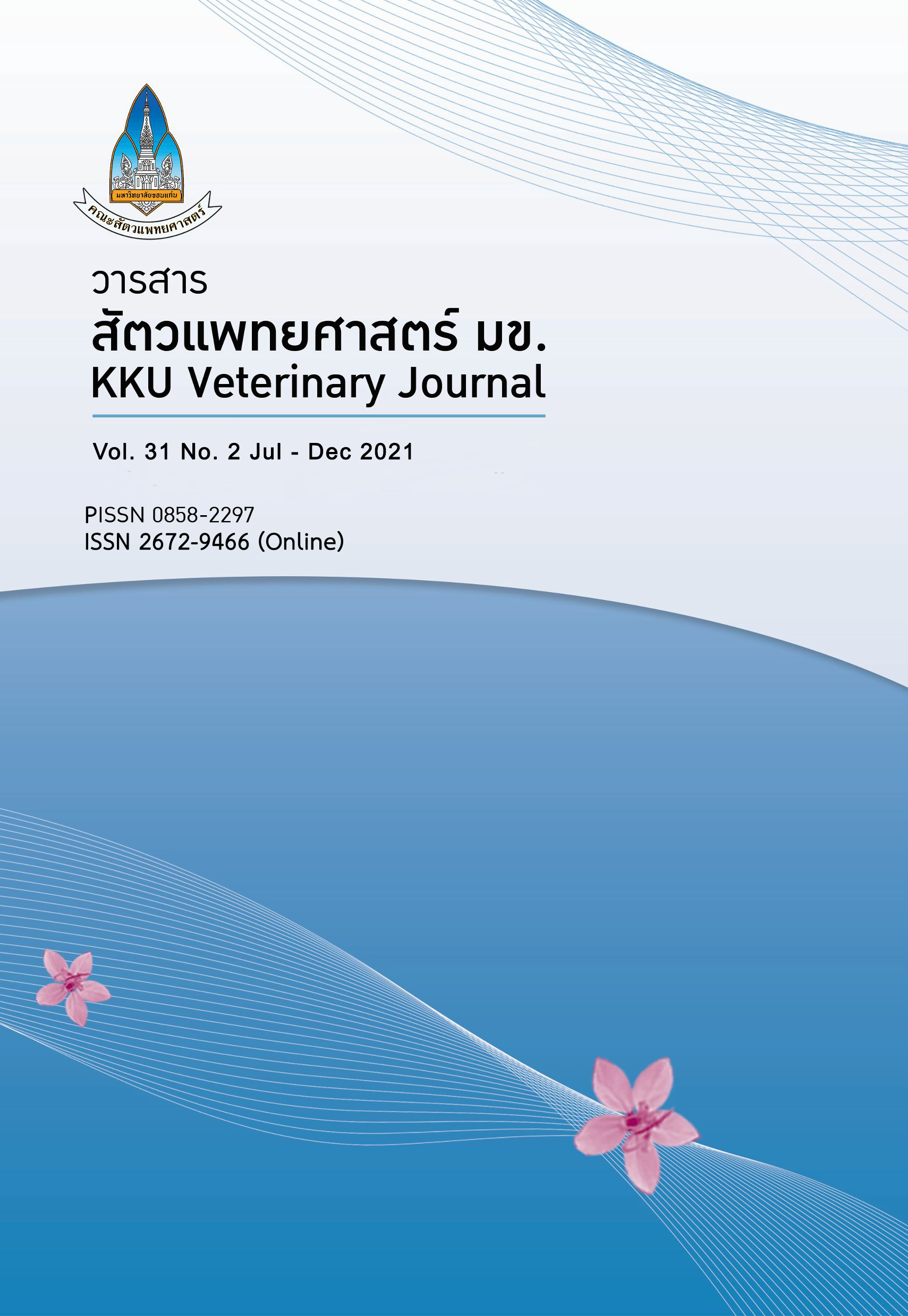การคัดแยกแบคทีเรียแลคติกที่ผลิตเอ็กโซพอลิแซกคาไรด์จากทางเดินอาหารสัตว์และอาหารหมักพื้นบ้านของไทย
Main Article Content
บทคัดย่อ
วัตถุประสงค์ เพื่อคัดเลือกแบคทีเรียแลคติกจากทางเดินอาหารสัตว์และอาหารหมักพื้นบ้านที่มีคุณสมบัติเป็นโปรไบโอติกและผลิตสาร Exopolysaccharides (EPS) เพื่อนำมาใช้ในการเลี้ยงสัตว์และอุตสาหกรรมผลิตภัณฑ์อาหารหมัก
วัสดุ อุปกรณ์ และวิธีการ กลุ่มตัวอย่างที่ศึกษามาจาก 5 แหล่ง ได้แก่ ทางเดินอาหารสุกร ทางเดินอาหารไก่ แหนมหมู หม่ำ และปลาส้ม ทำการคัดเลือกแบคทีเรียแลคติกโดยการทดสอบคะตะเลส ทดสอบการทนต่อกรด และด่าง ทดสอบการทนต่อน้ำดี ทดสอบการต้านยาปฏิชีวนะ ทดสอบการยับยั้งเชื้อก่อโรค และทดสอบการผลิตสาร EPS ด้วยวิธี phenol sulphulic method
ผลการศึกษา แยกแบคทีเรียแลคติกจำนวน 152, 161, 160, 174 และ 158 จากทางเดินอาหารสุกร ทางเดินอาหารไก่ แหนมหมู หม่ำ และปลาส้ม ตามลำดับ มี 761 ไอโซเลท ที่ให้ผลเป็นลบต่อการสร้างเอนไซม์คะตะเลส มีความทนต่อกรด และด่าง ที่ pH 2, 4 และ pH 10 เป็นเวลา 3 และ 6 ชั่วโมง มีจำนวน 176 ไอโซเลท และแบคทีเรียที่คัดเลือกได้ทั้ง 176 ไอโซเลทพบการต้านยาปฏิชีวนะต่อ amoxicillin clavulanic acid, oxytetracycline, streptomycin, vancomycin และTrimethoprim-sulfamethoxazole คิดเป็นร้อยละ 4.54, 50.57, 65.34, 73.86 และ 68.18 ตามลำดับ เชื้อแบคทีเรียที่คัดเลือกได้จำนวน 78 ไอโซเลท พบการยับยั้งเชื้อก่อโรค E. coli ATCC 25923, S. Typhi และ Listeria monocytogenes ได้มาก คิดเป็นร้อยละ 5.12, 5.12 และ 8.97 ตามลำดับ แบคทีเรียที่คัดเลือกได้ไอโซเลท F3-3, N45-1, C57, และ M 60-3 มีการผลิตปริมาณน้ำตาล (EPS) มากที่สุด คือ 3.21, 2.54, 2.36 และ 2.11 กรัมต่อลิตร ตามลำดับ
สรุป จากการผลการศึกษาของแบคทีเรียแลคติกที่คัดเลือกแล้ว 4 ไอโซเลท (F3-3, N45-1, C57, และ M 60-3) ที่มีความสามารถในการผลิต EPS ได้มากที่สุดจากไอโซเลททั้งหมด ซึ่งสามารถนำไปใช้เป็นสารเสริมในอาหารในการเลี้ยงสัตว์ และอุตสาหกรรมการผลิตอาหารหมักต่อไป
Article Details

อนุญาตภายใต้เงื่อนไข Creative Commons Attribution-NonCommercial-NoDerivatives 4.0 International License.
เอกสารอ้างอิง
Adesulu-Dahunsi AT, Jeyaram K, Sanni AI. 2018. Probiotic and technological properties of exopolysaccharides producing lactic acid bacteria isolated from cereal-based Nigerian fermented food products. Food Control 92, 225-231.
Clinical and Laboratory Standards Institute. 2016. Performance Standards for Antimicrobial Susceptibility Testing. 26th ed. Wayne USA. 94-104.
Dangmanee N, Plubjeen K, Saklutanasak W, Jaruvattanayon N. 2015. Isolation of Lactic acid bacteria from Fermented ground pork for Probiotic properties. RSU national research conference. 2017
Dubois M, Gilles KA, Hamilton JK, Rebers PA, Smith F. 1956. Colorimetric method for determination of sugars and related substances. Anal Chem 28, 350-356.
Dueramaeb S. 2016. Exopolysaccharides production by lactic acid bacteria and its application. Food J 48(3), 21-30.
Eilaf SK, Mohd YM, Shuhaimi M, Mehrnoush A, Amaal MA, Ahmed A. 2018. Probiotic characteristics of EPS producing Lactobacillus isolated from some traditional Malaysian fermented foods. CYTA J Food. 16(1), 287-298.
Fox ID, Robyt JF. 1991. Miniaturization of three carbohydrate analysis using a microplate reader. Anal Biochem 195, 93-96.
Gayathiri E, Bharathi B, Velu S, Siva N, Natarajan S, Prabavathi S, Selvadhas S. 2017. Isolation, identification and optimization of exopolysaccharide producing lactic acid bacteriafrom raw dairy sample. Inter J Pharm Chemical Res 3(2), 202-211.
Gilliland SE, Staley TE, Bush LJ.1984. Importance of bile tolerance of Lactobacillus acidophilus used as a dietary adjunct. J Dairy Sci 67(12), 3045-3051.
Jin, LZ, Ho MY, Abdullah N, Ali AM, Jalaludin S. 1998. Acid and bile tolerance of lactobacillus isolated from chicken intestine. App Microbiol 27, 183-185.
Halder D, Mandal M, Chatterjee SS, Kumar PN, Mandal S. 2017. Indigenous probiotic lactobacillus isolates presenting antibiotic like activity against human pathogenic bacteria. Biomedicine 5(2), 31.
Khalil ES, Manap MYA, Mustafa S, Alhelli AM, Shokryazdan P. 2018. Probiotic properties of exopolysaccharide producing Lactobacillus Strain isolated from Tempoyak. Molecules. 23.
Klaenhammer TR. 1993. Genetics of bacteriocins produced by lactic acid bacteria. FEMS Microbiol Rev 12, 39–85.
Linton JD, Ash SG, Huybrechts L. 1991Microbial polysaccharides. In Novel Material from Biological Source, 215-262.
Nuphet A, Kantachote D, Charernjiratrakul W. 2004. Screening of probiotic lactic acidbacteria from Thai fermented for human. J Sci technol 26(5), 659-670.
Maneerat S. 2000. Exopolysaccharides from lactic acid bacteria. Songklanakarin J Sci Technol 22(3), 397-402.
Sahulsawasdiphan K, Sornplang P. 2017. Antimicrobial activity of lactic acid bacteria isolated from animal gut and Thai traditional fermented foods against Escherichia coli ATCC 25922 and Salmonella Typhi. KKU Vet J 27(1-2), 15-32.
Sornplang P, Sakulsawasdiphan K, Piyadeatsoontorn S, Surasorn B. 2016. Antimicrobial susceptibility of lactic acid bacteria isolated from human and food-producing animal feces in Khon Kaen Province, Thailand. Trop Anim Health Prod 48(8), 1739-1745.
Torino MI, de Valdez GF, Mozzi F. 2015. Biopolymers from lactic acid bacteria novel applications in foods and beverages. Front Microbiol 6(834), 1-16.
Tungwatcharin P, Nithisanthawakub J, Suksupat K. 2016. Preliminary screening and selection of lactic acid bacteria with potential probiotic propertie from fermented meat products. King Mongkut’s Agric J 34(2), 67-76.
Whitster RL. 1998. Introduction of industrial Gums, In dustrial Gums. (Whistler R.L. and Bemiller J.N., eds.) p. 1-19. Academic Press. San Diego.
Yolmeh M., Khomeiri M. and Ahmadi Z. 2017. Application of mixture design to introduce an optimum cell-free supernatant of multiple-strain mixture (MSM) for Lactobacillus against food-borne pathogen. Food Sci Technol 83, 298-304.


